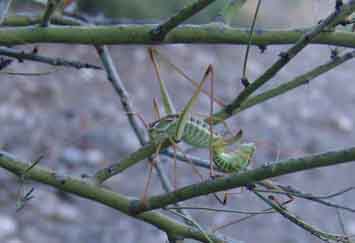Katydids and Crickets (Order Orthoptera, Suborder Ensifera)
Sources: a website of great value is Singing Insects of North America, by Thomas Walker and Thomas Moore. Click on that link.
Katydids and Crickets differ from short-horned grasshoppers in having antennae longer than their bodies (except in Mole Crickets).
KATYDIDS (8 Subfamilies in North America)
In contrast to North American true Crickets, Katydids usually have wings, and their tarsi have 4 segments. The name "Katydid" derives from a species that makes a song sounding like that. Most are large, and usually brown or green in color, mimicking vegetation. The males do the "singing" to attract mates, by scraping/filing their forewings.
Below, a kind of Katydid -- this looks like a "Straight-laced Meadow Katydid" (Conocephalus sp.), judging by the Walker & Moore website lists (?) -- seen on a lamp on a terrace above Lower Hot Springs Canyon in September 2003. Click on the image to enlarge it.

On September 08, 2004, we saw a strange creature in a Palo Verde tree -- it looked (below) like it had too many legs. Viewed from another angle on the right, it proved a copulating couple of Katydids of the same kind as shown above, the (considerably smaller) male on the bottom and to the right in the right-hand photo. Click on each image to enlarge it:
 ....
....
Moving around to different angles, the male shows up more prominently in the two photos below.
 ....
....
This pair appears to be of the same species as the one shown at the top.
Crickets (Family Gryllidae)
These "True Crickets" have somewhat flattened shapes, with rounded heads and long, threadlike antennae. Wings (when present) are folded flat over the body. Unlike the Katydids, they have 3-segmented tarsi. They grade in color mostly from brown to black. (McGavin p. 61)
This one below is one of our most common crickets, strongly black in color. Photographed in lower Sierra Blanca Canyon Wash in September 2006, it was hiding in the crevice out of sight, where the soil was still damp from recent floods. Click on each image to enlarge it:
 ...
...
And click here for an even closer view. This one has lost its left leg. Most species of True Crickets are ground dwellers.